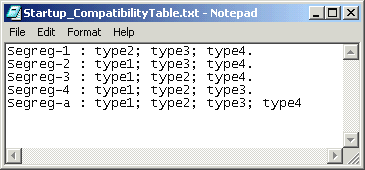The compatibility table contains the list of the separation codes.
The separation code is a criterion used as a filter applied to the segments. It is possibly used during the automatic routing: if the separation codes are compatible, the signal can follow the segments whereas, if the separation codes are not compatible, the route is forbidden.
This list is organized as follows: to each signal separation code (Segreg-1, Segreg-2, Segreg-3, Segreg-4, Segreg-a) corresponds one or more compatible segment separation codes (type1, type2, type3, type4).
The pattern is the following:
[Signal Separation Code]: [Compatible Segment Separation Code]; [...]; [Compatible Segment Separation Code].
It looks like this:
The first line of the table can be read: Segreg-1 is compatible with type2, type3 and type4.
Note that:
- A signal with an empty separation code can be routed on all the network segments
- A segment with an empty segregation allows all the signals routing
- A signal with the same separation code as a segment can be routed on this segment (even with no compatibility table)
- The separation code of the V4 bundle segments (BNS) can only be modified in CATIA V4 (E3MANAGE/MANAGE/Element)
- For the pathways, the separation code is modified using Edit > Properties
- For the signals, the separation code is defined using CATIA - Electrical Systems Functional Definition
